
Korean War Exhibit
The Korean War exhibit includes a display of vintage artifacts and a diorama depicting the attempted rescue of ENS Jesse L. Brown, the first African American to complete flight training and become a Naval Aviator, by squadronmate LTJG Thomas Hudner Jr. on December 4, 1950. The action, for which Hudner received the Medal of Honor, was the subject of a book and motion picture titled Devotion. The replica F4U-4 that is the centerpiece of the diorama depicting the snowy North Korean landscape around the Chosin Reservoir was a prop used in the filming of the movie. Read More

MiG-21 Fishbed
The MiG-21 (codenamed Fishbed by NATO) was one of the most widely produced fighter aircraft in history. Capable of nearly Mach 2, it was designed as a high-altitude interceptor with an excellent climb rate. In the dogfighting arena, the aircraft’s small size made it difficult to spot and it boasted excellent turning capability. Naval aviators first engaged MiG-21s in the skies over North Vietnam, with 17 confirmed kills. The aircraft on display is painted in the markings of the Iraqi Air Force. On the first day of Operation Desert Storm on 17 January 1991, two Navy F/A-18C Hornets shot down a pair of Iraqi MiG-21s.

USS Nimitz (CVN 68) Flight Deck
The USS Nimitz one-quarter scale replica flight deck highlights features of the modern nuclear-powered aircraft carriers that operate around the world. The island superstructure not only depicts that on board the real ship, but also serves as the ticket counter for the museum’s large screen theater. Nimitz entered service in 1975 as the lead ship of a class of 10 carriers, the newest of which is USS George H.W. Bush (CVN 77) commissioned in 2009. Read More
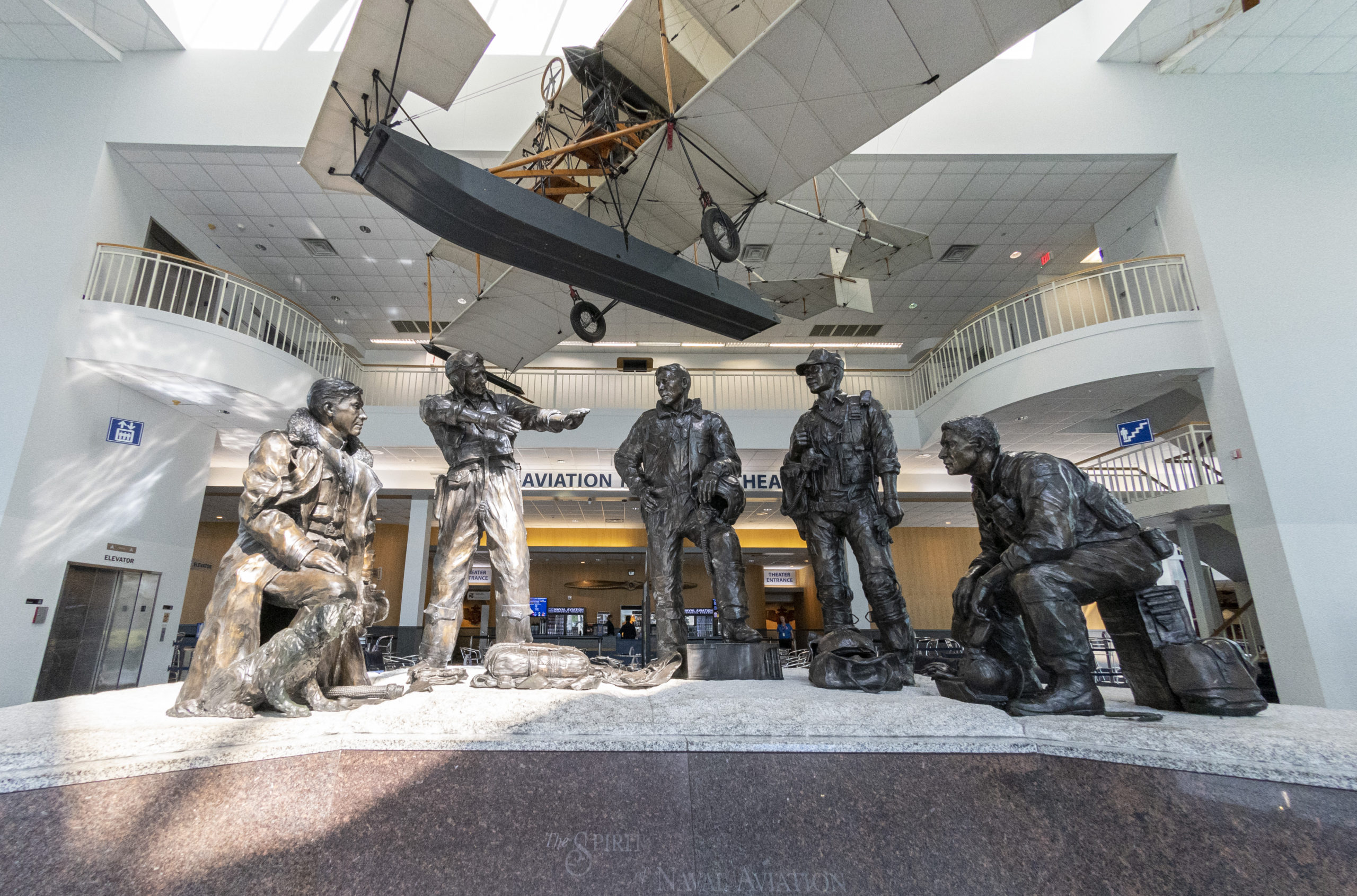
Spirit of Naval Aviation Monument
This monument depicts five Naval Aviators from various periods in history gathered together listening to the World War II aviator describe an air combat action. It welcomes visitors to the museum Quarterdeck, which derives its name from the ceremonial point of arrival and departure on board a ship. For visitors this area of the museum represents the portal to a journey through the exciting world and heritage of Naval Aviation.

A-1 Triad
The museum’s A-1 Triad is one of two replicas of the Navy’s first airplane built to commemorate the 50th anniversary of Naval Aviation in 1961. The name Triad reflected the fact that it could operate from the water using the single float, on land using wheels and in the air. The A-1 was the airplane in which Lieutenant Theodore G. Ellyson, the Navy’s first aviator, made many of his early flights, including testing catapults that would allow airplanes to fly from ships.

D-558-1 Skystreak
A subsonic research airplane designed to evaluate high-speed flight, the D-558-1 was aptly nicknamed the “Crimson Test Tube” by the press that covered its test program. Two Naval Aviators, Commander Turner F. Caldwell and Marine Major Marion Carl, established world speed records in the Skystreak in August 1947 over what is now Edwards Air Force Base, California. Their marks held until the breaking of the sound barrier by Air Force Captain Chuck Yeager on October 14, 1947.

F9F-2 Panther
The Navy’s front-line fighter during the Korean War, the Panther scored the first air-to-air kills by a jet aircraft in Naval Aviation history. Astronauts John Glenn and Neil Armstrong, as well as Boston Red Sox slugger Ted Williams, flew F9Fs during the war. The museum’s airplane is a combat veteran of both Navy and Marine Corps squadrons and in its final years of service was a jet trainer at Naval Air Station Pensacola. Read More

Dawn of Naval Aviation
The Navy ordered its first airplane in 1911, just eight years after the Wright Brothers made the first powered flight. From seaplanes that logged record-setting transoceanic flights to the development of combat aircraft and the floating airfields known as aircraft carriers, Naval Aviation’s first decades of service laid the foundation for its enduring role in the nation’s defense.

NC-4
The name Charles Lindbergh is synonymous with flying across the Atlantic, but the NC-4 flying boat was the first to conquer that ocean in a multi-legged flight with stops in Canada, the Azores Islands and ultimately Portugal. On loan from the Smithsonian National Air and Space Museum since 1974, this is the actual aircraft, not a replica. Top speed for the NC-4 on its epic flight in May1919 was 85 m.p.h. Fifty years later, man walked on the moon, a startling fact demonstrating the rapid technological advancement that is a hallmark of aviation.

Naval Aviation in the Great War
This diorama captures various scenes from the Naval Aviation experience in the World War I era, from the sandy shores of Pensacola where wood and fabric seaplanes operated from tent hangars to a muddy airfield on the Western Front. A civilian purchased the MF-Boat on display after it completed its Navy service and at one time, it provided aerial tours of Atlantic City, New Jersey.

Sopwith Camel
One of the most famous fighters of World War I, the British-made Camel got its nickname from the hump that housed the machine guns located forward of the cockpit. Nineteen-year-old Lieutenant (junior grade) David Ingalls became the Navy’s first fighter ace, a status achieved by shooting down five or more enemy aircraft, while flying a Camel during World War I. The airplane on display depicts one that operated from a makeshift wooden flight deck on board the battleship USS Texas (BB 35) in 1919 evaluating the operation of wheeled airplanes from ships.

FF-1
Nicknamed “Fifi” (a play on its FF-1 designation), the airplane was produced by Grumman, the same company that eventually developed the F-14 Tomcat of TOPGUN fame. Its metal fuselage, enclosed cockpit canopy and retractable landing gear were innovative for the early 1930s. Discovered in a junkyard in Nicaragua, the museum’s airplane is an export version of the FF-1. Read More

F3F-2
The F3F-series was the last biplane fighter in front-line service in Naval Aviation. A Navy salvage vessel recovered the museum’s airplane from the Pacific Ocean in 1990, 50 years after its pilot ditched while attempting to land on board the aircraft carrier USS Saratoga (CV 3). The pilot was Marine First Lieutenant Robert Galer, who later received the Medal of Honor for heroism at Guadalcanal during World War II.

BFC-2 Goshawk
The BFC-2 was an early example of a divebomber, the pilot descending at high speed and a steep angle to drop ordnance on a target. To prevent the bomb from hitting the propeller when dropped, a bomb sling or cradle swung it out away from the fuselage. The markings on the museum’s airplane are those of Bombing Squadron (VB) 2B, known as the High Hats, a squadron still in existence today as the Tophatters flying the F/A-18 Super Hornet. Read More

RR-5 Tri-Motor
Built by Ford Motor Company, the Tri-Motor was one of the nation’s early airliners. Its corrugated metal construction inspired a popular nickname for the airplane—the “Tin Goose.” Built in 1928, the airplane on display was a corporate airplane for a Missouri power company, supported firefighting in Montana and flew in air shows around the country before donation to the museum in 1973.

SB2U-2 Vindicator
The SB2U represented one of the major developments in aircraft design before World War II—the shift from biplanes to monoplanes. Despite this advancement, it was a transitional design, most of its surfaces covered in fabric. The airplane on display is the only example of the Vindicator in existence and was recovered from Lake Michigan, where it crashed during World War II carrier qualification training.

F4F-3 Wildcat
The Navy’s front-line fighter for the first part of World War II, the Wildcat flew in the landmark battles at Coral Sea, Midway and Guadalcanal, with eight F4F pilots receiving the Medal of Honor. A unique design feature of the airplane was the fact that the pilot had to retract the landing gear himself by turning a lever in the cockpit between 28 and 32 times. The aircraft on display flew from USS Wasp (CV 7) as part of the Neutrality Patrol in the Atlantic before the United States entered World War II.

Prowling the Burma Road: The Flying Tigers
Its centerpiece a P-40B Tomahawk fighter with the famous shark mouth on its cowling, this exhibit tells the story of the American Volunteer Group (AVG), its members recruited from the ranks of the U.S. military. Called the Flying Tigers, they were contract pilots of a private company and paid by the Chinese government to fight against the Japanese. They flew their first missions after the Pearl Harbor attack and disbanded on July 4, 1942.
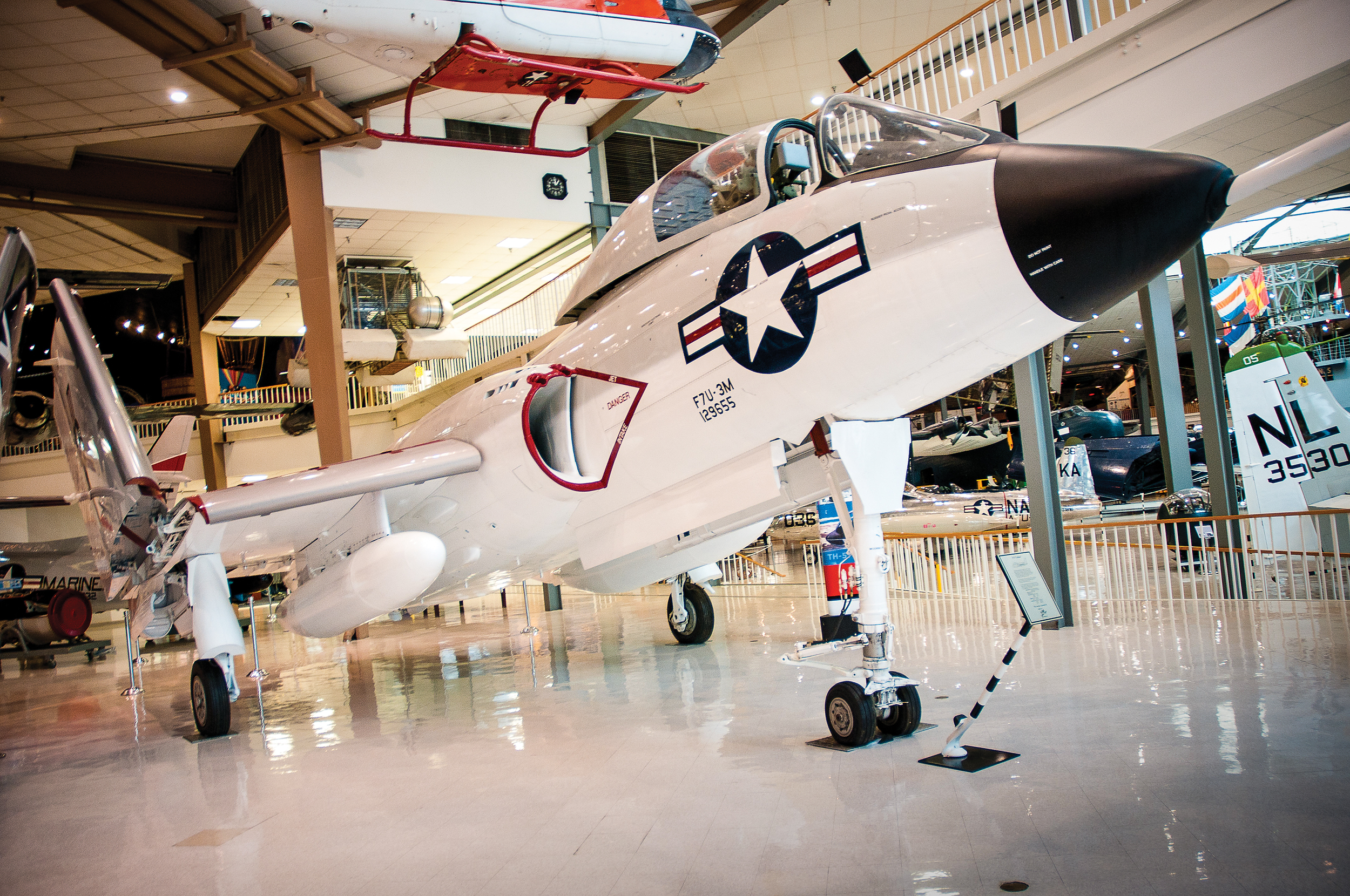
F7U-3M Cutlass
One of the unique airplanes in Naval Aviation history, the Cutlass featured a tailless design, the vertical stabilizers positioned on the wings. One of the airplane’s major faults was that it was underpowered, prompting the nickname “Gutless Cutlass.” The Blue Angels evaluated it as a possible air show aircraft, wisely turning it down.

F11F-1 Tiger
The fuselage of the F11F-1 was a so-called Coke bottle design, bending inward over the wings to improve airflow in high-speed flight. A civilian test pilot once shot himself down during a flight in a Tiger, the jet intakes ingesting spent shell casings after he fired the guns, damaging the engines. The Tiger on display made its last flights in air shows in 1968 while serving as Blue Angel Number 1, the flight leader’s airplane.

F4D-1 Skyray
The Skyray had an appropriate nickname; when viewed from above the shape of its rounded delta wing resembled a stingray. Pilots called it the “Ford” based on its F4D designation. The airplane boasted a rapid climb rate, which prompted its use in an experimental project investigating launching a satellite using a rocket fired from an F4D.

Skylab Command Module
Before the modern International Space Station, a laboratory known as Skylab orbited the earth during the period 1973–1979. The museum displays the command module that carried an all-Navy crew consisting of astronauts Pete Conrad, Paul Weitz and Joseph Kerwin to Skylab, where they spent 28 days in orbit during May–June 1973. This spacecraft is on loan from the Smithsonian National Air and Space Museum.

B-25J Mitchell
On April 18, 1942, sixteen of these Army Air Forces medium bombers flew one of the most daring missions in military history, launching from USS Hornet (CV 8) to bomb Japan. All volunteers under the command of Lieutenant Colonel James Doolittle, the Doolittle Raiders sparked a boost in morale for the American public and proved the vulnerability of the Japanese Home Islands. The Marine Corps procured examples of the Mitchell for use later in the Pacific, designating them PBJs.

PBY-5 Catalina
One of the most versatile aircraft of World War II, the PBY flew a range of missions, including hunting for German U-boats, low-level night attacks against Japanese positions and air-sea rescue of downed aviators. PBYs were the aircraft that first spotted the approaching Japanese fleet during the Battle of Midway in June 1942. In the lowered position the PBY’s wing tips served as floats when the flying boat was on the water.

PBY Catalina Cutaway
This exhibit includes the fuselage of a PBY damaged in an accident at Naval Air Station Pensacola during World War II and displayed on the base for decades afterward. It provides a close-up look at the interior layout of the venerable flying boat and the various positions where crewmen worked to enable the airplane to fly its multi-hour missions. A healthy supply of pencils was always a necessity on board the airplane; when rivets popped in the hull during hard landings, the crew jammed pencils into the holes until permanent repairs were made.
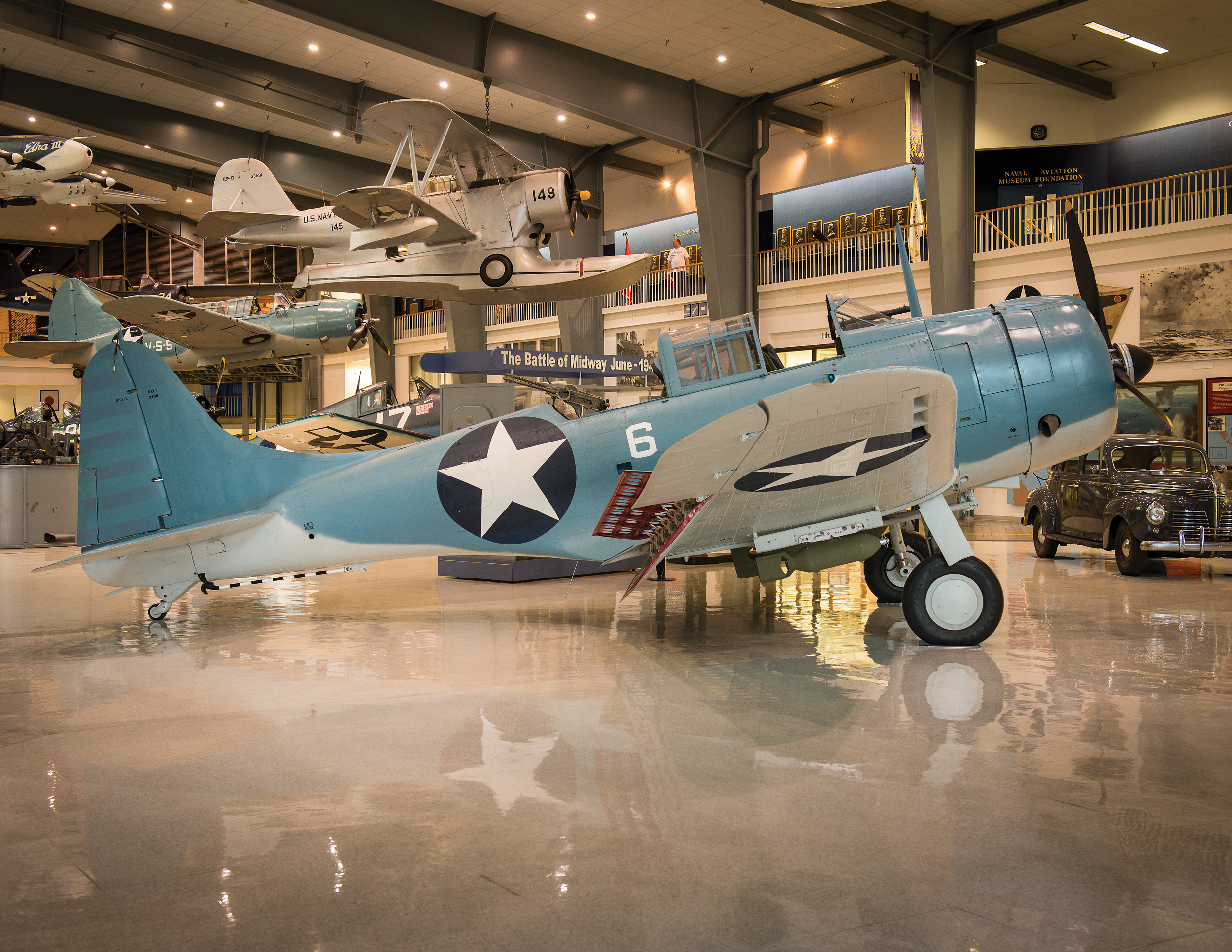
SBD-2 Dauntless
The museum’s Dauntless is one of the most historically significant aircraft in the collection. It survived Pearl Harbor and attacked Japanese shipping in New Guinea while flying from USS Lexington (CV 2) on March 10, 1942. The lone remaining airplane to have participated in the Battle of Midway in June 1942, it returned from an attack against the Japanese fleet with over 200 bullet holes in its fuselage, the patches covering them still visible in places on the airplane.

F6F-3 Hellcat
The Navy’s front-line fighter during the final two years of World War II, the F6F produced more aces, including leading Navy ace Commander David McCampbell, than any other Allied aircraft. At peak production the airplane’s manufacturer delivered one Hellcat an hour around-the-clock. The aircraft on display is a combat veteran of the Solomon Islands campaign having flown with Fighting Squadron (VF) 38, including missions escorting a plane carrying Vice Admiral William F. “Bull” Halsey.

FG-1D Corsair
Originally produced by Vought, the Corsair was in production by multiple manufacturers longer than any piston-engine fighter and flew combat missions in both World War II and Korea. Its most recognizable design feature was an inverted gull wing that was necessary to keep the blades of its 13-ft. propeller from striking the ground. During air combat missions in World War II, more than one Marine pilot downed a Japanese plane by chopping off its tail with this large propeller.

TBM-3E Avenger
Nicknamed the “Turkey,” the Avenger entered service at the Battle of Midway and was the largest airplane assigned to fly from carriers during World War II. This was the type airplane flown by future President of the United States George H.W. Bush during his World War II service as a Naval Aviator. In one of the most enduring aviation mysteries, on December 19, 1945, Flight 19 consisting of five TBM Avengers disappeared during a flight over the Bermuda Triangle.

PB2Y-5R Coronado
The museum’s airplane is one of a select number of Coronados use by high-ranking officers and features a plush interior and all of the conveniences possible in an airplane of the era. This airplane transported members of Fleet Admiral Chester W. Nimitz’s staff to the surrender ceremonies ending World War II, becoming one of the first American airplanes to land in Tokyo Bay. Before its donation to the museum, billionaire aviator and Hollywood mogul Howard Hughes owned the airplane.
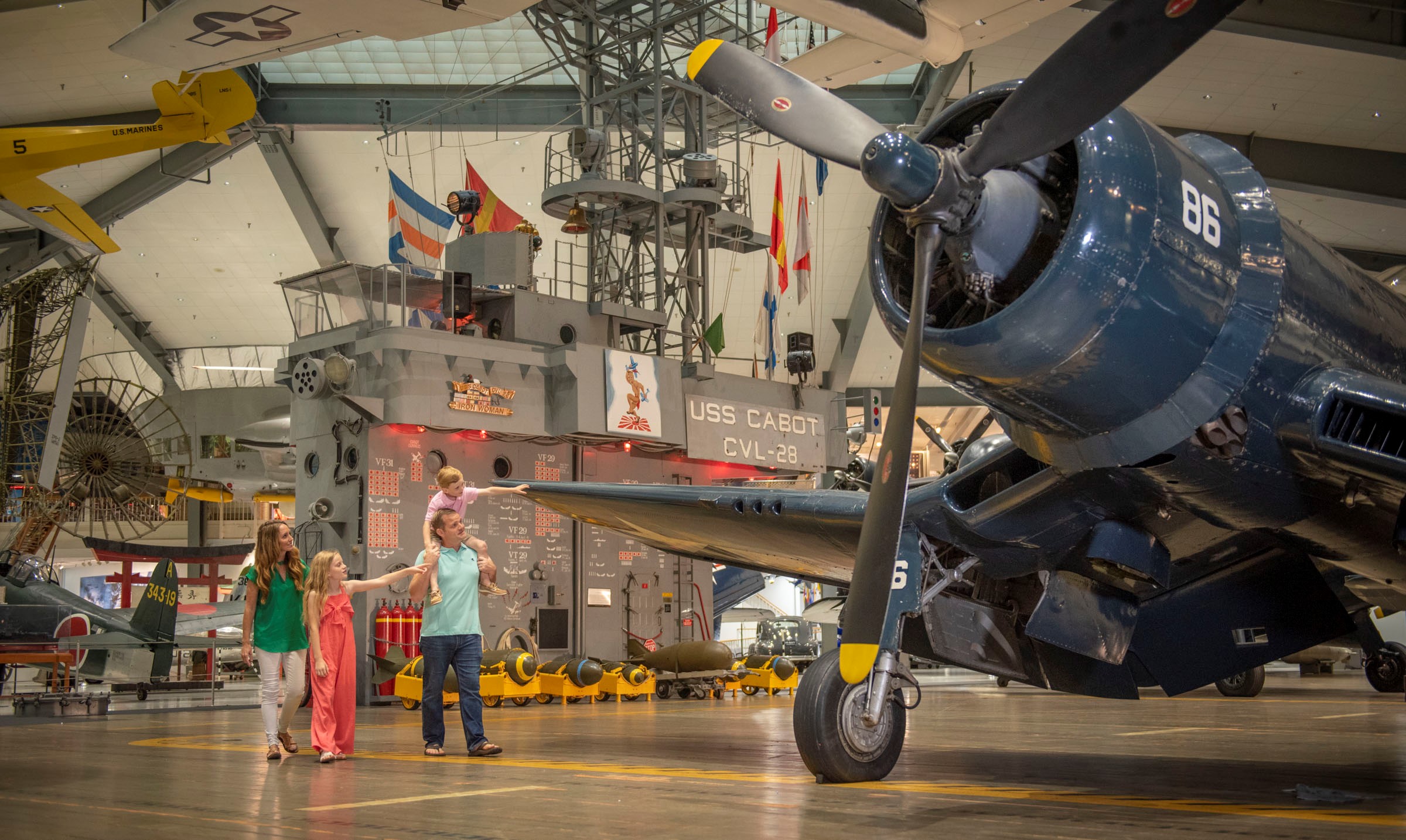
USS Cabot (CVL 28) Flight Deck
This exhibit depicts the decorated light carrier USS Cabot and includes a replica of the wooden flight deck and island superstructure. Assisted by his son, the same sailor who painted the original scoreboard highlighting the combat record of the ship and its embarked air groups duplicated his work for the museum. Famed war correspondent Ernie Pyle spent time on board Cabot, the only aircraft carrier he ever visited, and gave her the nickname the “Iron Woman.”

Underwater Treasures of Lake Michigan
The museum began recovering aircraft from the bottom of Lake Michigan, where they crashed during World War II carrier qualification, in the early 1990s. This exhibit takes visitors to the depths, preserving an F4F Wildcat and SBD Dauntless in the conditions in which they were found after spending decades underwater. A short film produced exclusively for the museum by the History Channel documents the story of Naval Aviation training in the Great Lakes.

Home Front U.S.A.
The first of a series of dioramas depicting the World War II experience paints a portrait of life on the home front where rationing and scrap drives were a part of normal life. Many of the businesses represented are actual establishments from Pensacola in that era, and a number of the “Hometown Heroes” whose pictures appear in the storefront window are original museum volunteers photographed during their World War II service.

Pacific Island
Stepping through the facade of the U.S. Navy Recruiting Station, visitors leave Home Front U.S.A. and find themselves at a Pacific island airfield with an FM-2 Wildcat fighter as its centerpiece. From rustic tent living quarters to an oil barrel shower to the ubiquitous sign showing the distance to Tokyo and places back home, the exhibit highlights the island-hopping campaign that took Allied forces to the doorstep of Japan.

Life on an Aircraft Carrier
The final element of the World War II diorama takes visitors through the passageways of a wartime carrier to include the sounds of circulated air, pounding hammers and the high-pitched bosun’s pipe. Shipboard spaces include the ready room where aviators received briefings on their missions, the all-important parachute loft and the gedunk, the naval term for the shipboard snack bar. Visitors can also see an F6F-5 Hellcat painted in the markings of the Navy’s leading ace, Commander David McCampbell.

USS Enterprise Exhibit
The most decorated ship of World War II, USS Enterprise (CV 6) fought in nearly every significant battle of World War II. The exhibit devoted to her history features original components from the ship and a highly detailed model depicting the aircraft carrier during the Battle of the Philippine Sea in June 1944. A flag that flew from the ship’s mast during the Battle of Santa Cruz in October 1942, a gift to landing signal officer Lieutenant Robin Lindsey, is also part of the exhibit.

K-Class Control Car
Blimps provided an effective way to combat enemy submarine attacks against convoys because they could remain airborne much longer that conventional aircraft. On only one occasion did a K-class airship engage an enemy submarine, the crew of a German U-boat shooting it down with a deck gun. Museum staff located the control car in a junkyard near Naval Air Station Lakehurst, New Jersey, and spent years restoring it.

L-8 Control Car
Procured from Goodyear to support the expansion of Naval Aviation’s airship fleet, the L-8 delivered vital parts to USS Hornet (CV 8) after the carrier departed California carrying the Doolittle Raiders and their aircraft for their famous raid on Tokyo. The L-8’s most famous flight inspired the nickname Ghost Ship, the blimp with the control car on display crashing in Daly City, California, on August 16, 1942, after launching on a patrol earlier in the day. Its two-man crew was not on board and remains missing. After its wartime service, the L-8 returned to civilian service as one of the famous Goodyear blimps that flew over landmark sporting events.
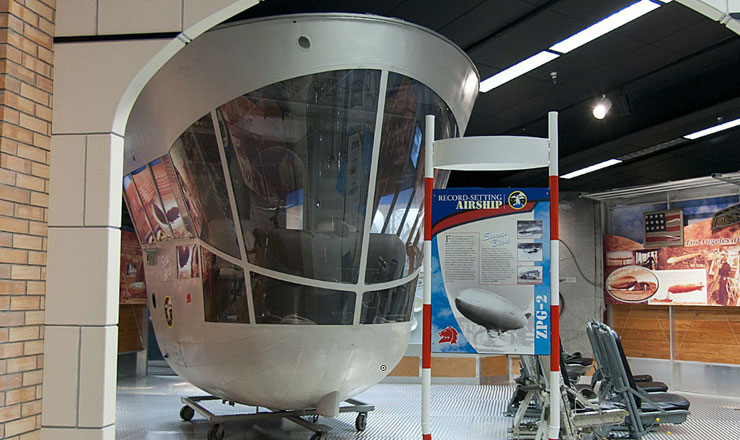
ZPG-2 Snow Bird
The museum displays the cockpit section of the ZPG-2 Snow Bird, which on March 15, 1957, established a long-distance unrefueled flight record when it landed at Naval Air Station Key West, Florida, after traveling a distance of 9,448 miles. During the flight, it spent 264.2 hours straight in the air. President Dwight D. Eisenhower presented Commander Jack R. Hunt, commander of Snow Bird, the Harmon International Trophy for this achievement.
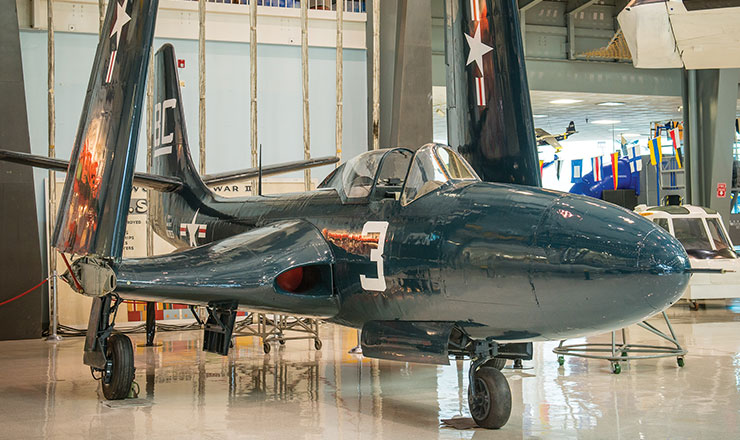
FH-1 Phantom
The initial design for the FH-1 Phantom featured three small jet engines on each wing before finalization of the twin-engine design. The airplane was the Navy’s first operational jet and made its maiden flight on January 26, 1945. The top speed for the Phantom was 479 m.p.h., which was some 60 m.p.h. slower than the first successful combat jet in history, the German Me-262.

F2H-2P Banshee
The Banshee received its nickname because of the wailing sound that its engine made. Both fighter and photoreconnaissance versions of the airplane flew in Korea, the latter one like that displayed in the museum featuring a longer nose to house cameras. Filled with concrete, the airplane on display was once a fixture at a children’s park in Vero Beach, Florida.

Apollo: The Path to the Moon and Beyond
Opened on the 50th anniversary of man first walking on the moon, this exhibit located in the museum’s Emil Buehler Naval Aviation Library tells the story of Naval Aviation’s spirit of exploration. Highlights include artifacts from record-breaking flights and famed polar explorer Rear Admiral Richard Byrd. Also included is the story of Naval Aviator astronauts from Project Mercury to the International Space Station.

A-4E/F Skyhawk
Soaring in the famous diamond formation of the Blue Angels are four A-4 Skyhawks, the type airplane flown by the U.S. Navy Flight Demonstration Squadron from 1974 to 1986. In actual practice the aircraft fly closer than the display represents with just 36 inches separating the airplanes as they roar through the sky. In fleet service, the A-4 may have been diminutive in size—its nickname was the “Tinker Toy”—but it proved a workhorse in the Vietnam War, where it was Naval Aviation’s primary attack airplane.

SNJ-5C Texan
An advanced trainer in World War II and primary trainer in the postwar era, the SNJ played a role in instructing thousands of Naval Aviators. The version on display featured a tailhook for use in carrier qualification where students made their initial arrested landings on an aircraft carrier. Among those who flew a Texan in this milestone event was Neil Armstrong, who later became the first man to walk on the moon.

N2S-3 Kaydet
Though nicknamed the Kaydet, the airplane was universally called the Stearman after its manufacturer and served as a primary trainer for the both the Navy and Army Air Forces. This particular airplane served for a time at Naval Air Station Minneapolis, Minnesota, where in January 1943, future President George H.W. Bush made two flights in it during his training to become a Naval Aviator. In the postwar years, it flew as a crop-duster before acquisition by the museum. Read More

A-1H Skyraider
Called the finest close air support aircraft ever built with the ability to carry more ordnance than a four-engine World War II B-17 Flying Fortress, the Skyraider flew in both Korea and Vietnam. It was originally designated the AD, which prompted the nickname “Able Dog.” The airplane on display was the last attack version of the Skyraider to fly a combat mission in Vietnam in 1968. Read More

F-4N Phantom II
One of the most widely used and capable warplanes in history–it established 12 world records when first introduced–the F-4 was originally intended to intercept Soviet bombers at high altitude with missiles. The Vietnam War forced a shift in its operations as it attacked targets on the ground and engaged in dogfights with enemy fighters. The museum’s display aircraft shot down a North Vietnamese MiG-19 in air-to-air combat on May 18, 1972.

F-8A Crusader
The first operationally-equipped aircraft to exceed 1,000 M.P.H., the F-8 was nicknamed the “Last of the Gunfighters” because it carried 20-millimeter cannon and its pilots placed an emphasis on dogfighting skills, which paid dividends during the Vietnam War. With its cockpit position far forward on the fuselage, the Crusader incorporated a variable-incidence wing that could be raised during takeoff and landing, in the latter keeping the fuselage parallel to a carrier deck or runway to provide excellent visibility for the pilot. Read More
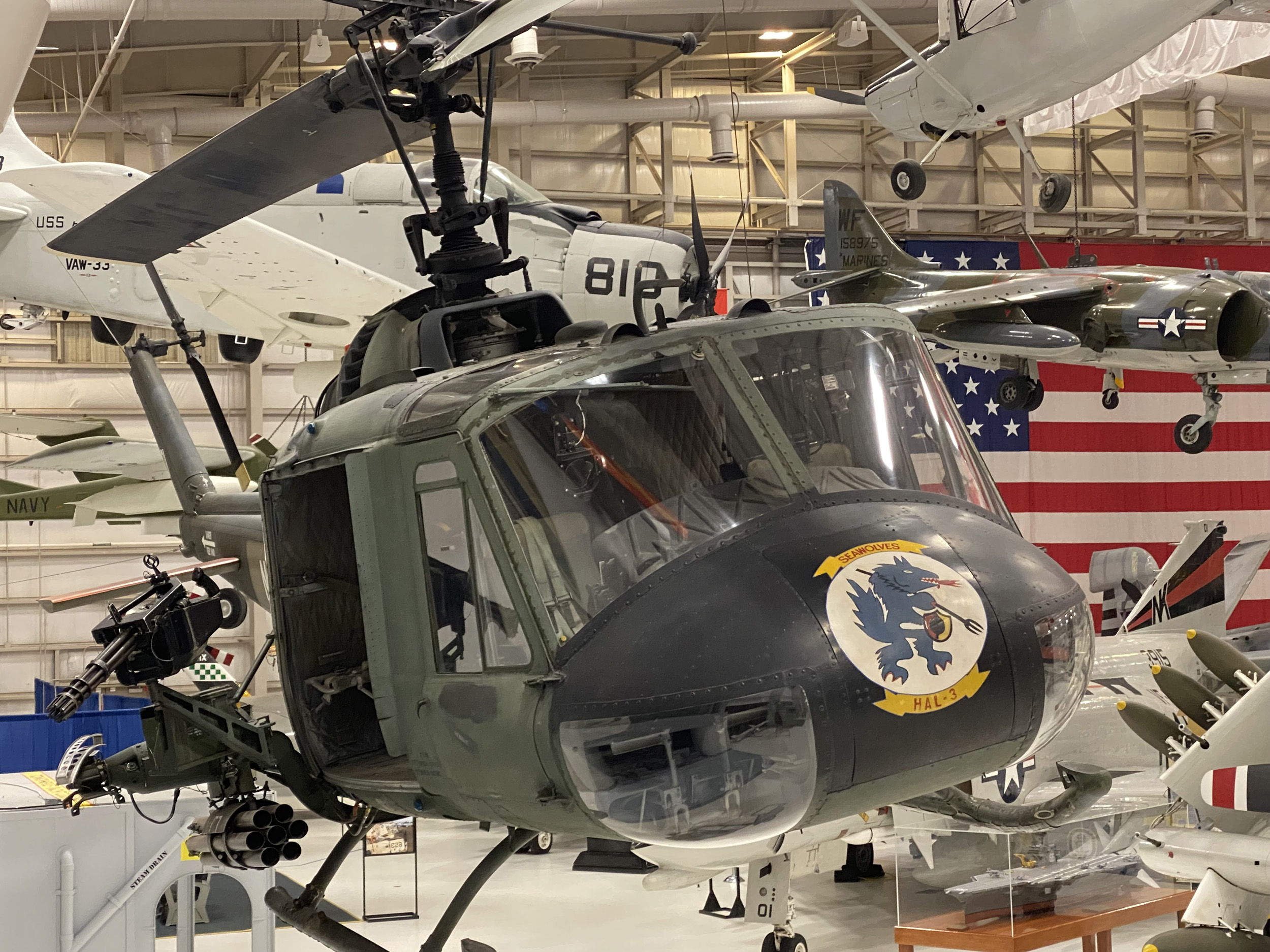
HH-1K Iroquois
Procurement of this version of the famed “Huey” helicopter that was a veritable symbol of the Vietnam War occurred in 1968. In Marine Corps service, the Iroquois transported ground troops to landing zones as part of heliborne assaults and provided medical evacuation. The museum displays the HH-1K in the markings of a gunship flown by the Seawolves of Helicopter Attack Squadron (Light) (HA(L)) 3, established and disestablished during the Vietnam War to provide air support for operations in the Mekong Delta. Read More

A-7E Corsair II
The Corsair II both entered and retired from service in combat, the A-7A flying in Vietnam beginning in 1968 and the A-7E logging the aircraft’s final operational missions during Operation Desert Storm in 1991. The museum’s aircraft participated in the latter action, delivering ordnance over Iraq and Kuwait, including the first strikes against Baghdad on the opening night of the air war. With the airplane’s gaping jet intake located on the underside of the fuselage, carrier flight deck personnel had to be extra careful working around it when its engine was operating. Read More

A-6E Intruder
One of the most technologically advanced aircraft in the Navy’s inventory when introduced in the mid-1960s, the Intruder featured radar and navigation equipment that enabled all-weather operations. During the Vietnam War, a number of A-6 crews received Navy Crosses for extraordinary heroism in single-plane raids on heavily defended targets, approaching at extremely low altitude and avoiding numerous surface-to-air missiles fired at their airplanes. Intruders, which could carry up to 18,000 pounds of ordnance, also flew strikes against Libya and in Operation Desert Storm before their retirement from service in the late 1990s.

O-1E Bird Dog
This example of the two-place observation aircraft used for aerial spotting appeared over USS Midway (CVA 41) on April 29, 1975, during the evacuation of South Vietnam. On board were a South Vietnamese Air Force major, his wife and 5 children, a note dropped from the cockpit requesting permission to land on the aircraft carrier. After the ship’s captain ordered some helicopters pushed over the side, the pilot successfully landed on the flight deck, the family eventually settling in the United States.

Vietnam POW Exhibit
On August 5, 1964, Lieutenant (junior grade) Everett Alvarez, Jr., became the first American aviator shot down and made a prisoner of war (POW) in North Vietnam. More followed him into captivity during the intensive air campaigns of the Vietnam War, the captivity in the foreboding prisons like Hoa Lo, which the POWs called the “Hanoi Hilton,” marked by torture, solitary confinement and horrific living conditions. The museum’s exhibit tells the story of this experience from captivity to joyous homecomings in 1973.

The Forrestal Fire
Fire is one of the greatest calamities that can occur aboard ship. On July 29, 1967, during flight operations on board USS Forrestal (CVA 59), a rocket accidentally launched from an aircraft on the flight deck and ignited a fuel tank on another airplane. The resulting conflagration killed 134 Sailors and injured 161 others while causing extensive damage to the ship and aircraft. This exhibit includes a memorial plaque and the stern plate bearing the carrier’s name removed before the ship’s scrapping.
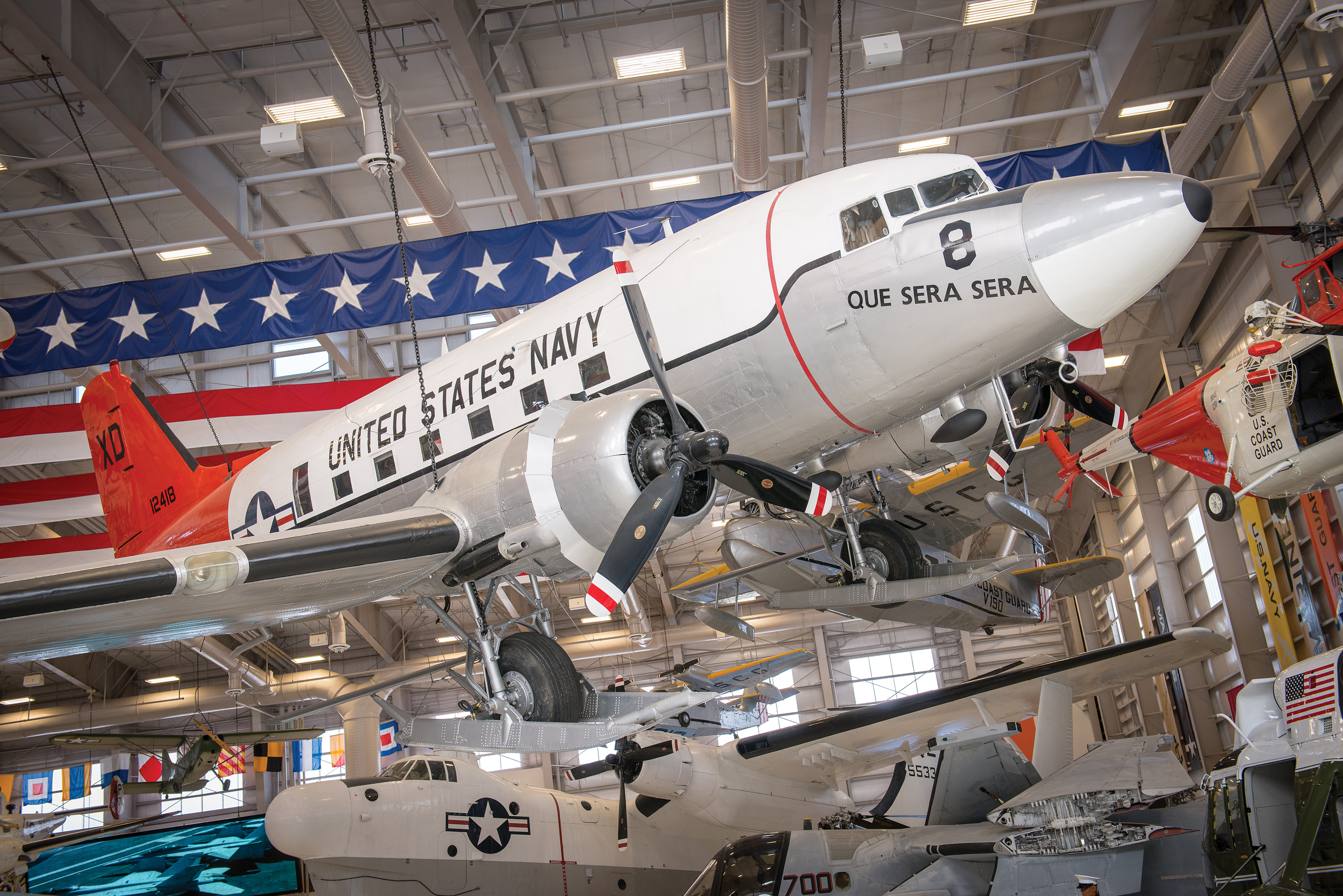
R4D-5L Skytrain
A unique version of the C-47 Skytrain that dropped paratroopers into Normandy during the D-Day invasion, the museum’s R4D-5L is the famous “Que Sera Sera.” Its landing gear fitted with skis, it made the first landing by an airplane at the South Pole on October 31, 1956. Another Naval Aviator, Rear Admiral Richard Byrd, and his crew had become the first to fly over the South Pole in 1929.

P2V-1 Neptune
With the advent of nuclear weapons, the Navy evaluated the abilities of its newest aircraft and their crews to perform long-range missions. Nicknamed the “Truculent Turtle” in the tradition of the old fable The Tortoise and the Hare, the P2V-1 Neptune on display was slow but steady in establishing a world record for long-distance unrefueled flight. Packed with as much fuel as it could carry, the airplane completed a flight from Perth, Australia, to Columbus, Ohio, on October 1, 1946, after traveling a distance of 11,235 miles in 55 hours and 17 minutes. The record stood until 1962. Read More

Lunar Module
A replica of the Lunar Module, the spider-like spacecraft that carried the astronauts to the lunar surface, is the centerpiece of the museum’s exhibit devoted to the Apollo program. Also on display is an example of the boilerplate capsules used by the Navy to practice spacecraft recovery after splashdown and details about the specific American moonshots. Both the first and last man to walk on the moon, Neil Armstrong and Eugene Cernan, were Naval Aviators.

RD-4 Dolphin
U.S. military purchasers of the airplane, originally built as an “air yacht” for the commercial market, included the Navy, Army Air Corps and Coast Guard, the latter service procuring 13 of the airplanes and naming each of them after a star (i.e. Rigel, Vega). In Coast Guard service, the planes flew primarily in the search and rescue role, the first Distinguished Flying Crosses ever awarded to Coast Guardsmen coming as the result of open-sea rescues of fishermen by pilots of RD Dolphins. The museum’s aircraft, originally purchased in 1934 by William Boeing, founder of the Boeing Airplane Company, later flew with Alaska Airlines.

HO3S-1G
The museum aircraft entered service in 1950 and flew entirely with the Coast Guard, including a September 4, 1951, mission in which the pilot deployed its flotation bags to land in the Atlantic Ocean to pull an Air Force pilot from the water after he parachuted from his plane. The original purchase price for an HO3S was less than $92,000 and the type entered service in Naval Aviation in 1946, one of its first missions being support of Operation Highjump, an expedition to Antarctica. The first helicopter pilot to receive the Medal of Honor, Lieutenant (junior grade) John Koelsch, was an HO3S pilot shot down during an attempted rescue of a downed Marine pilot in Korea and died while a prisoner of war.

HH-52A Sea Guard
The HH-52 took helicopter search and rescue to a new level when delivered in 1963. With its watertight hull and stabilizing floats on each side of the fuselage, the Sea Guard could land on water or an ice cap to assist those in distress as well as pull them to safety using a rescue hoist. The helicopter on display served for 24 years, accumulating over 13,737 flight hours and more than 800 search and rescue missions that saved over 600 lives. When retired from service in 1987, it was one of the oldest helicopters flying in the Coast Guard.

F-14D Tomcat
Known in Naval Aviation circles as the “Big Fighter,” the F-14 featured a unique variable sweep wing that automatically shifted in flight from 28 to 60 degrees sweep for optimum performance at any speed. The Tomcat made headlines during the 1980s in air-to-air engagements with Libyan fighters over the Gulf of Sidra. The aircraft on display made the last combat flight by an F-14, its 224th and final combat sortie occurring on February 8, 2006, over Iraq flying from the deck of USS Theodore Roosevelt (CVN 71).

E-2C Hawkeye
The aircraft carrier’s command and control platform, the Hawkeye has the distinctive feature of a 24-foot diameter circular rotating radar dome atop the fuselage. The airplane was once nicknamed the “Hummer” because of the noise its four-bladed props made. The eight-bladed props visible on the museum’s airplane, which create a sound akin to a swarm of bees, increase fuel efficiency and create less vibration on the airframe. The E-2C on display made its final flight to the museum in May 2014, and is displayed in the markings of its last squadron, Carrier Airborne Early Warning Squadron (VAW) 123, the Screwtops.

VH-3A Sea King
Delivered to the fleet in 1962, the VH-3A on display served in the Executive Flight Detachment of Marine Helicopter Squadron (HMX) 1 during the presidencies of Richard M. Nixon and Gerald R. Ford. No single helicopter is called “Marine One,” with any one of HMX-1’s aircraft assuming that name when the President is on board. The white top portion of the familiar paint scheme on board “Marine One” originally appeared in an effort to make the aircraft cooler for its passengers prior to the availability of air-conditioned compartments.

S-3B Viking
The Viking entered service in 1974 as a platform for hunting Soviet submarines, the end of the Cold War shifting the airplane’s role to surveillance, aerial refueling and precision targeting against enemy forces and infrastructure on the ground. After flying combat missions during Operation Iraqi Freedom, on May 1, 2003, this airplane transported President George W. Bush when he became the first sitting president to make a carrier arrested landing, trapping on board the USS Abraham Lincoln (CVN 72). During its service, the Viking received the nickname the “Hoover” because of the vacuum-like sound its engines made.

SH-60B Seahawk
The SH-60B was the first version of the Seahawk to enter service, becoming operational in 1983. The Seahawk is a versatile platform employed at sea in the antisubmarine and anti-ship roles, and used extensively for search and rescue, drug interdiction, cargo lift and insertion of Special Operations Forces into hostile landing zones. During its service, the helicopter on display logged 8,785 flight hours and more than 28,000 landings, its last one on the occasion of its transfer to the museum in 2009.
SH-2F Seasprite
The H-2 Seasprite entered service as a utility helicopter in 1962 and was modified to fly combat search and rescue in Vietnam. In June 1968 a Seasprite crew performed a daring night rescue of two downed aviators, the helicopter’s pilot, Lieutenant Clyde E. Lassen, receiving the Medal of Honor. The aircraft on display is a Light Airborne Multi-Purpose System (LAMPS) SH-2F with a high-powered radar on the underside of the fuselage. It could search and strike the enemy over the horizon with an array of weapons and also provide missile defense using electronic jamming equipment.
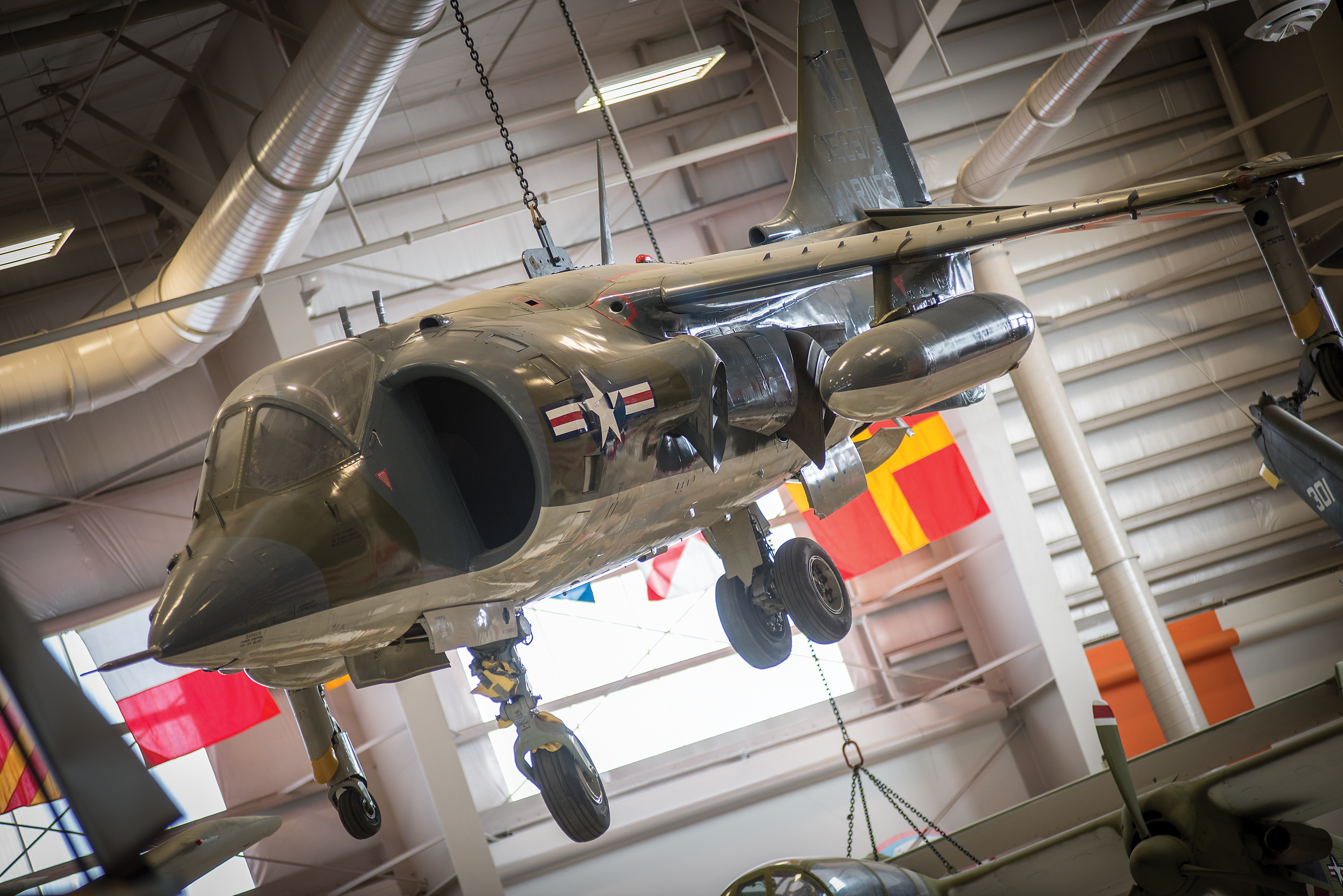
AV-8C Harrier
The Harrier utilizes the concept of “Vectored Thrust,” in which turbine by-pass air is routed to one of two pairs of moveable nozzles at the wing roots, while jet exhaust is directed through the second pair. The combined “thrusts” enable the airplane to either hover or fly normally depending on the position of the nozzles. This vertical short take-off and landing (VSTOL) capability allows AV-8s, which in Naval Aviation operate exclusively with the Marine Corps, to fly from makeshift airfields near the front lines or amphibious assault ships, thereby providing a quick response in the close air support of ground troops.

AH-1W Super Cobra
The AH-1W entered service in 1986, and during Operation Desert Storm five years later Marine Corps squadrons flying them destroyed 97 tanks and 104 armored vehicles. The Super Cobra boasted an array of offensive firepower, including 20 mm cannon, rockets and precision-guided munitions, which made it a potent platform for providing close air support for Marines on the ground. The aircraft on display, which was flight delivered to the museum in 2019, is a combat veteran of service in both Iraq and Afghanistan.
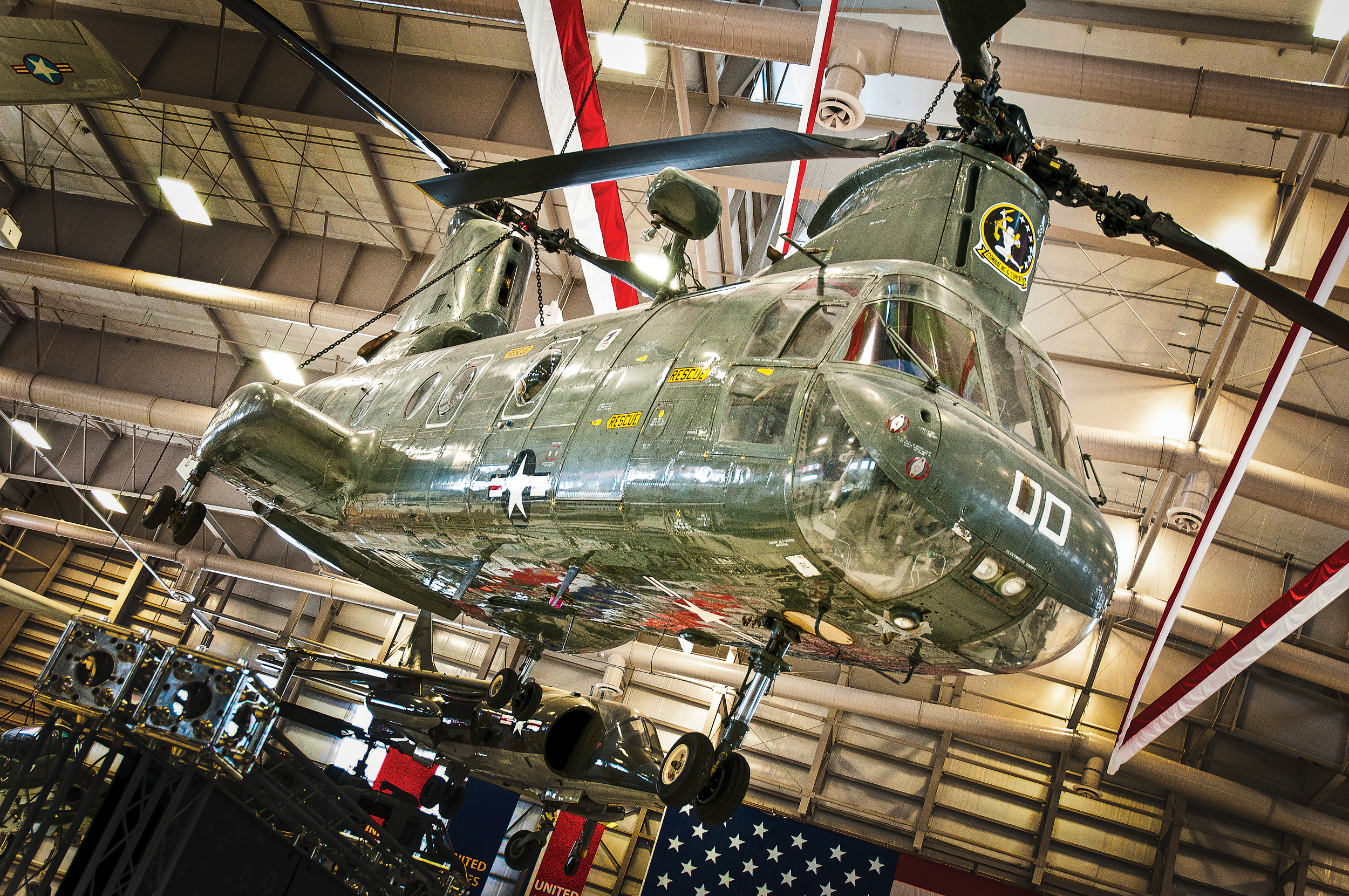
CH-46D Sea Knight
The tandem-rotor CH-46 entered service during the Vietnam War and operated until Marine Corps squadrons retired it in 2015. Nicknamed the “Phrog” by Marines, the CH-46 has been likened to a flying bus with its ability to deliver troops to landing zones and evacuate wounded personnel. One of the original design parameters of the Sea Knight was the capability to hoist 10,000 pounds externally, which made it ideal for the role of vertical replenishment transferring cargo between supply ships and warships at sea. The helicopter on display spent many hours performing this mission in distant ocean waters, its final flight with Helicopter Combat Support Squadron (HC) 6 ending with a landing at the museum in 2003.
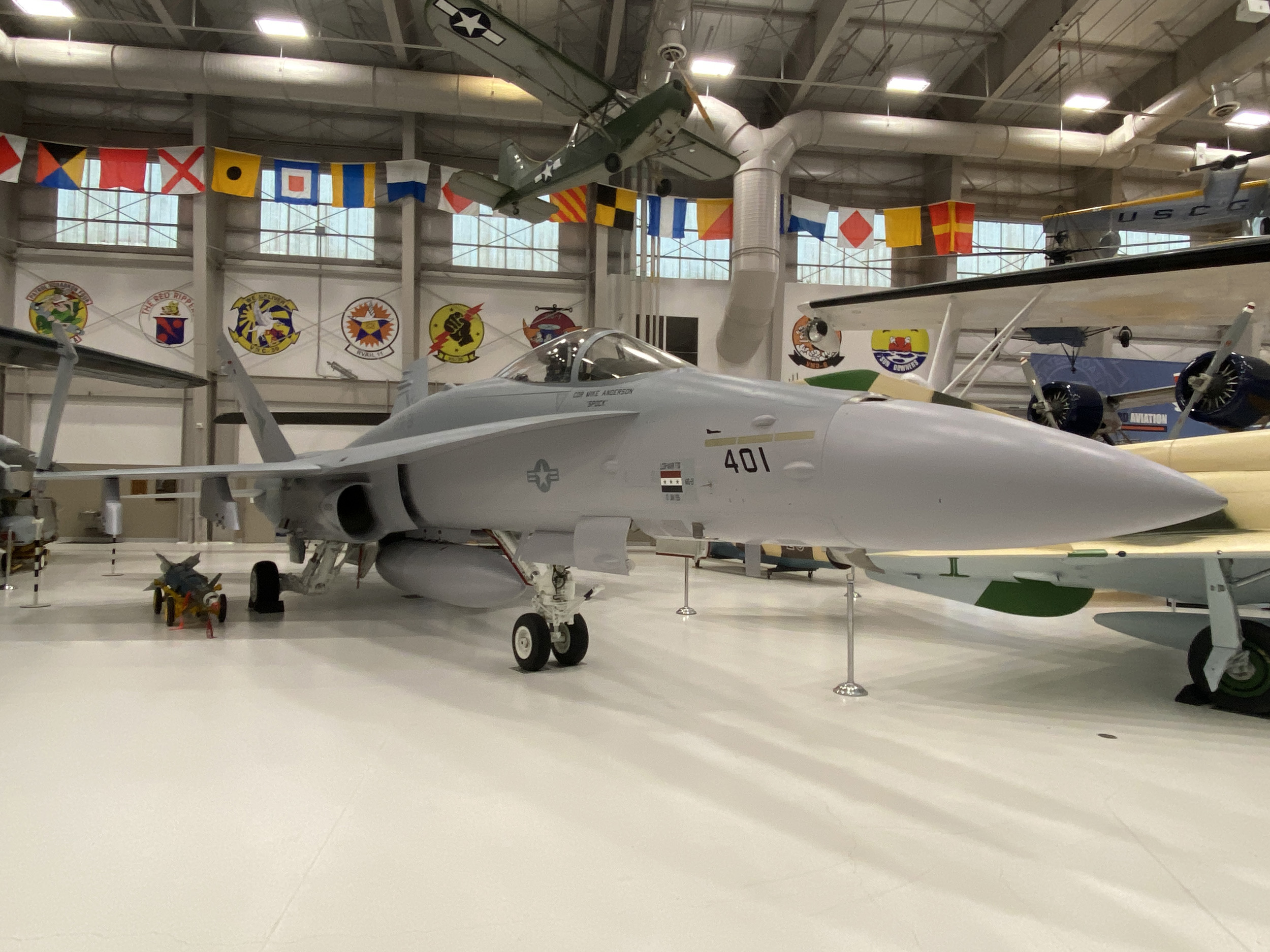
F/A-18C Hornet
The first naval aircraft designed specifically as a multimission strike fighter, proficient in both the air-to-air and air-to-ground arenas, the F/A-18 Hornet entered operational service in 1982. The F/A-18C variant like that on display operated aboard aircraft carriers until 2021. The museum’s aircraft is one of two Hornets that shot down Iraqi MiG-21 Fishbed fighters on the first day of Operation Desert Storm on January 17, 1991. The pilot on that mission was LCDR Mark “MRT” Fox of the VFA-81 Sunliners off USS Saratoga (CV 60). Read More

HH-3F Pelican
A variant of the “Jolly Green Giant” employed by the U.S. Air Force in Vietnam for combat search and rescue, the HH-3F Pelican differed in its nose-mounted radar and watertight fuselage that allowed for water landings. The aircraft on display outside Hangar Bay One as part of the Coast Guard Aviation exhibit was the last operational HH-3F and made its final flight in 1994, completing 22 years of operational service. Its most notable mission occurred in the waters off Sitka, Alaska, on December 10, 1987, when the helicopter’s crew braved heavy seas and hurricane-force wind gusts to rescue a father and son from their sinking boat. All of the rescuers received the Distinguished Flying Cross for their skilled airmanship and bravery.

CH-53D Sea Stallion
One of the last operational CH-53Ds in the Marine Corps, the helicopter on display flew its last combat missions in Helmand Province, Afghanistan, in 2012 while assigned to the Ugly Angels of Marine Heavy Helicopter Squadron (HMH) 362. Cargo was the name of the game for the CH-53D, which could either carry 37 combat-equipped Marines, 24 wounded personnel on litters, or 8,000 lb. of cargo. In an overload assault configuration, the fuselage carried over 12,000 lb. of materiel.

T-34C Turbo Mentor
From 1977 until the airplane’s last instructional flight in 2012, Student Naval Aviators completed primary, the first stage of flight training, in the T-34C. Thousands of individuals received their first Navy flight time learning the basics of flying in the T-34C, their nearly 70 hours in the cockpit including the first solo. Top speed of the T-34C was 322 m.p.h. and it could reach an altitude of 25,000 ft.

F/A-18A Hornet
A strike fighter equally adept at delivering ordnance against targets on the ground and engaging the enemy in air-to-air combat, the F/A-18 Hornet entered service in 1980. Both Navy and Marine Corps aircraft figured prominently in Operation Desert Storm, where they delivered over 17,500 tons of ordnance and scored the Navy’s only MiG kills. Hornets also provided vital air support in the skies over Afghanistan and Iraq supporting the Global War on Terror. The Blue Angels flew their first show in the F/A-18 Hornet in 1987 and it is the longest-serving aircraft in their history. The museum displays Hornets in tactical and Blue Angels markings.

TOPGUN Legacy Aircraft
The Navy Fighter Weapons School, famously known as TOPGUN, began operations in 1969 to improve the air-to-air warfighting skills of fighter aircrew. The museum displays a T-38A Talon that flew with TOPGUN during the 1970s. Lieutenant Commanders Mugs McKeown and Jack Ensch, who in Vietnam teamed up to shoot down two enemy MiG-17 fighters and whose names are painted beneath the cockpits of the T-38, served as TOPGUN commanding officer and executive officer respectively. The school has used variants of the U.S. Air Force’s F-16 as adversary aircraft. The F-16N Viper on display wears the camouflage markings of the F-16A/B Fighting Falcons currently operated by TOPGUN.

The Flight Line
Located behind the museum’s aircraft maintenance and restoration hangar, the flight line is home to an array of aircraft that are part of the museum’s collection. These include two historic examples of the C-130 Hercules in the form of the Blue Angels’ famous Fat Albert and the airplane that made a series of landmark carrier launches and recoveries on board USS Forrestal (CVA 59) in 1964. Also displayed are versions of the AJ Savage and A3D Skywarrior, which were the Navy’s early carrier-based nuclear bombers, and an array of Navy transport aircraft, including one that was the personal airplane of the Commander-in-Chief, U.S. Pacific Fleet during the Vietnam War.